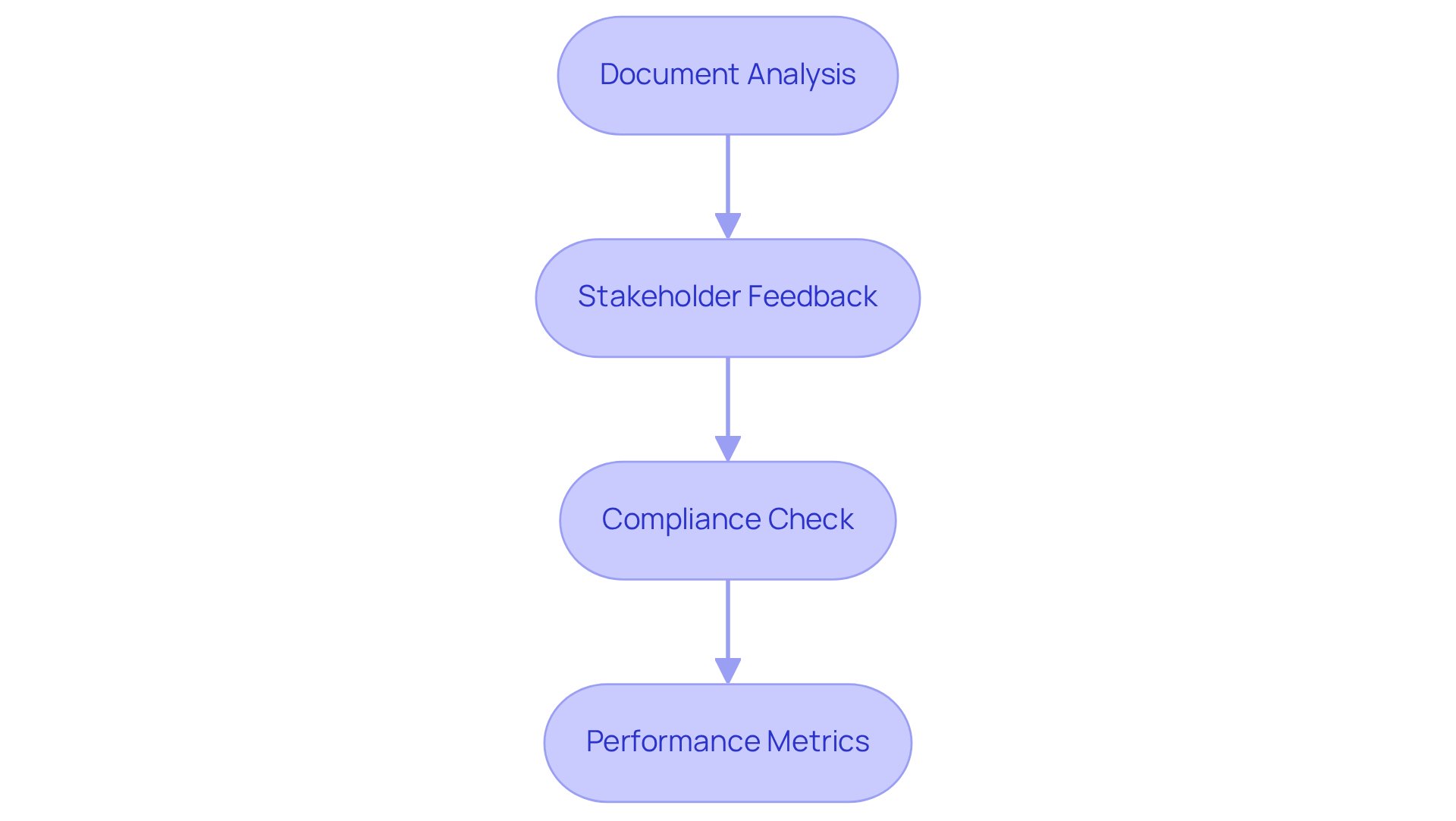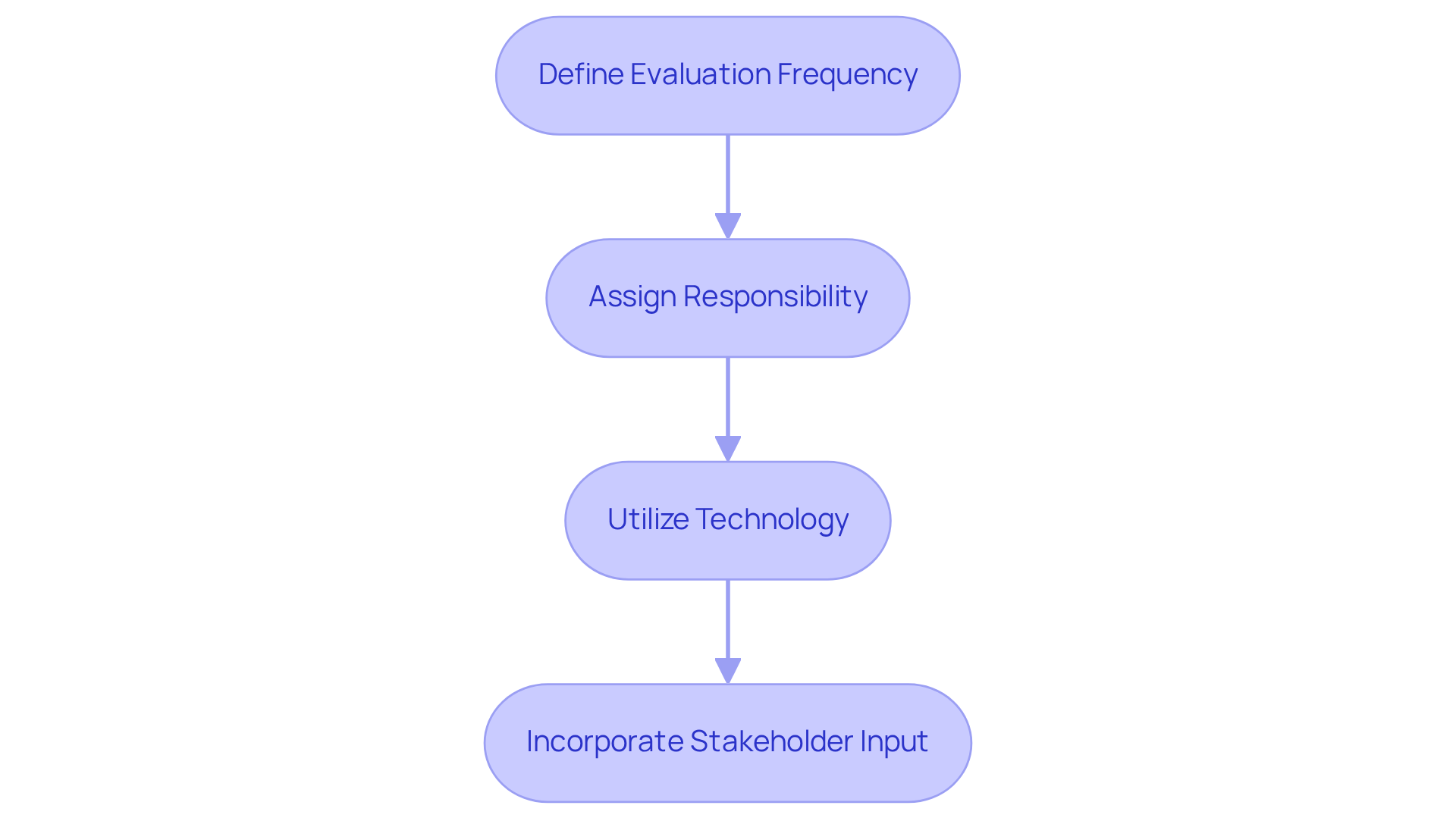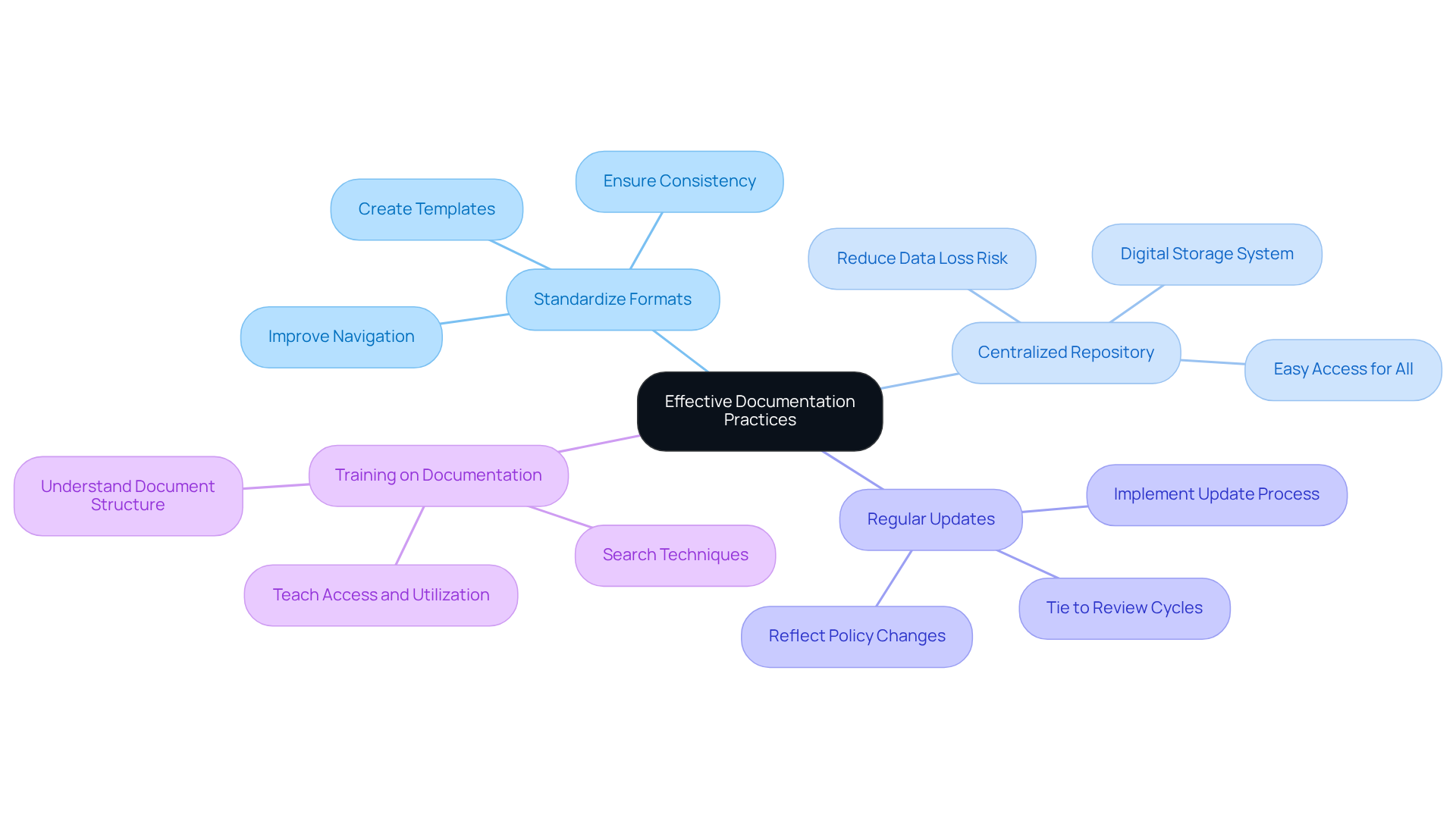
Overview
You might be wondering how to effectively follow policies in operations management. Well, here are four best practices that can really make a difference!
- Conducting thorough document analyses is key. It helps you understand what’s working and what’s not.
- Gathering stakeholder feedback is crucial. After all, who knows the processes better than the people involved?
- Regularly performing compliance checks ensures that everyone is on the same page and following the rules.
- Utilizing performance metrics is fantastic for enhancing operational effectiveness.
Evidence shows that when organizations regularly evaluate their processes and engage employees, they see a significant boost in policy adoption rates and overall efficiency.
Ultimately, fostering a culture of compliance isn’t just about following rules; it’s about creating an environment where everyone feels involved and valued. So, why not take a moment to reflect on these practices? Think about how they could help your organization thrive!
Key Highlights:
- Conduct a document analysis to review current guidelines for relevance and effectiveness, reducing inefficiencies.
- Gather stakeholder feedback through surveys or focus groups to improve adoption rates of new initiatives.
- Perform compliance checks to ensure guidelines align with laws, potentially reducing financial losses.
- Utilise performance metrics to evaluate how well regulations support operational goals, enhancing efficiency.
- Implement training programmes by conducting needs assessments to tailor content to specific skills gaps.
- Create interactive learning modules to improve engagement and retention in training sessions.
- Establish a regular schedule for training updates to keep employees informed about policy changes.
- Set up a feedback mechanism to continuously improve training programmes based on employee input.
- Define evaluation frequency for policy reviews to align with operational needs and regulatory requirements.
- Assign responsibility for evaluations to ensure thoroughness and accountability in maintaining guidelines.
- Utilise technology to automate reminders for policy reviews and track changes, improving compliance.
- Incorporate stakeholder input during evaluations to identify practical challenges and enhance guideline effectiveness.
- Standardise documentation formats to ensure consistency and ease of navigation.
- Create a centralised digital repository for easy access to all guidelines and procedures.
- Implement regular updates to keep documentation current and relevant.
- Provide training on documentation practises to ensure effective use of resources.
Introduction
You might be wondering why sticking to policies in operations management is such a big deal. Well, it’s not just a box to check off; it’s really the backbone of efficiency and compliance. When organizations get the hang of implementing their policies, they can reap some serious rewards—think better operational effectiveness and a more engaged workforce. But here’s the kicker: many companies struggle to keep their policies relevant and effective in a world that’s changing faster than ever.
So, how can they tackle this challenge while also building a culture of continuous improvement and compliance? Let’s dive into that! It’s all about finding the right balance and making sure everyone’s on the same page.
Assess Current Policies and Procedures
You might be wondering how to effectively assess your following policies and procedures. Well, it all starts with a comprehensive review that covers a few key areas:
-
Document Analysis: First off, gather all your current guidelines and procedures. Take a good look at their relevance, clarity, and effectiveness. Are there any outdated or redundant documents hanging around? This step is super important! Organizations that regularly analyze their documentation can cut down on inefficiencies and boost compliance rates significantly.
-
Stakeholder Feedback: Next, let’s talk about involving your employees. Getting insights from folks at every level can really shed light on how feasible and efficient your existing guidelines are. Think about using surveys or focus groups—they can provide some valuable insights. Research shows that companies that incorporate stakeholder feedback into evaluations see a 30% higher adoption rate of new initiatives. Plus, projects with solid stakeholder plans succeed 83% of the time. That really underscores the importance of this engagement, doesn’t it?
-
Compliance Check: Now, let’s make sure all your guidelines are in line with relevant laws and regulations. This step is crucial to avoid any legal headaches and keep your operations running smoothly. Organizations that prioritize compliance often see a reduction in financial losses by up to 15%. That’s a big deal!
-
Performance Metrics: Finally, take a look at your performance data. How well do your current regulations support your operational goals? Look for trends that might indicate areas needing improvement. Businesses that use performance metrics in their review processes can boost their operational efficiency by up to 20%. That really highlights the power of data-driven decision-making.
By following policies and these steps, you can create a clear picture of your current policy landscape. This clarity is essential for informed decision-making and strategic planning. Plus, it not only fosters compliance but also enhances overall operational effectiveness. For example, Hino Motors has rolled out continuous improvement initiatives in their HR department, showing just how beneficial effective stakeholder engagement and document analysis can be.

Implement Comprehensive Training Programs
To implement effective training programs, you might be wondering where to start. Well, organizations should really focus on a few key strategies:
-
Needs Assessment: First off, conducting a thorough analysis is crucial. You want to identify the specific development needs across different departments and roles. This targeted approach ensures that the training is relevant and directly addresses any skills gaps within the organization. Think of a needs assessment as the foundation for impactful educational initiatives. And hey, using SowFlow's instant documentation solution can make this process a breeze by giving you quick access to all the relevant data and resources. That way, you can tailor your instruction to what’s actually needed.
-
Interactive Learning Modules: Next up, let’s talk about creating engaging educational materials. Incorporating interactive elements like quizzes, case studies, and role-playing scenarios can really spice things up. These features not only boost learning retention but also cater to different learning styles, making the whole experience more effective and enjoyable.
-
Continuous Development: Now, it’s important to establish a regular schedule for learning sessions. Keeping employees updated on policy changes and reinforcing best practices is key to following policies. This could include refresher courses and orientations for new hires, ensuring everyone is on the same page with current operational standards. Plus, with SowFlow's instant documentation solution, all your educational materials are just a click away, making it easier for teams to find what they need and enhancing the onboarding process.
-
Feedback Mechanism: Lastly, don’t forget about setting up a solid feedback system. It’s essential for employees to share their thoughts on how effective the program is. Using this feedback helps you continually improve your instructional content and delivery methods, fostering a culture of growth and adaptability.
By focusing on these key areas and following policies, companies can truly cultivate a culture of compliance and operational excellence. This ultimately leads to better performance and happier employees. And hey, being aware of common pitfalls in the needs assessment process can help you dodge mistakes that might hinder training effectiveness. So, what do you think? Ready to dive into these strategies?

Establish Regular Policy Review and Update Cycles
To set up effective policy review and update cycles, you might be wondering what best practices organizations should follow. Here’s a friendly guide to help you out:
-
Define Evaluation Frequency: First off, it’s super important to create a clear timetable for assessments based on how complex and relevant each guideline is. Think about common intervals like annual or biannual evaluations. This way, policies can stay in sync with current operational needs and regulatory requirements. Did you know that a study found 41% of organizations that faced a significant event last year linked it to third-party participation? That really highlights the need for regular evaluations to keep risks at bay.
-
Assign Responsibility: Next, let’s talk about accountability. Designate specific individuals or teams to oversee the evaluation process. This not only promotes thoroughness but also ensures that regulations are checked regularly, reducing the chances of outdated or inefficient procedures. As Emily Bonnie, a digital marketing strategist, puts it, "Regular examination and modification are a crucial component of every plan for managing procedures and guidelines."
-
Utilize Technology: Now, let’s dive into tech! Using management software can be a game changer. It helps automate reminders for upcoming reviews and keeps track of changes over time. This not only boosts efficiency but also lightens the administrative load, letting teams focus on more strategic tasks. Organizations that embrace these tools often see improved compliance and lower costs.
-
Incorporate Stakeholder Input: Lastly, don’t forget to seek feedback from the folks who deal with the guidelines every day. Their insights can reveal practical challenges and highlight areas for improvement, making sure the guidelines are user-friendly and effective. Involving employees in the evaluation process can help avoid common pitfalls, like outdated guidelines leading to compliance issues.
By following policies, organizations can maintain a flexible framework that adapts to changing operational needs, ultimately boosting compliance and efficiency. For instance, the Xoralia management tool at TwinStream has shown just how effective these best practices can be in optimizing management processes. So, what do you think? Ready to give these strategies a try?

Utilize Effective Documentation Practices
You might be wondering how to make your documentation practices a bit better. Well, here are some friendly tips to get you started:
-
Standardize Formats: Think about creating templates for all your procedural documents. This way, you’ll have consistency in language, structure, and presentation. It makes everything easier to navigate and understand, right?
-
Centralized Repository: How about setting up a centralized digital storage system? This is where all your guidelines and procedures can live. Just make sure it’s easy for everyone to access—no one likes hunting for information!
-
Regular Updates: It’s super important to keep your documentation fresh. Implement a process for regularly updating everything to reflect any changes in following policies or procedures. You could tie this to your established review cycles to keep it simple.
-
Training on Documentation: Don’t forget about training! Providing your team with the know-how to access and utilize the documentation effectively is key. Teach them how to search for information and understand the structure of the documents.
By adopting these practices, you’ll not only support your operational goals but also enhance overall efficiency. So, why not give it a try? Your team will thank you!

Conclusion
You might be wondering why ensuring compliance with operational policies is such a big deal. Well, it’s not just about ticking boxes; it’s a key part of effective management that really drives success in any organization. By embracing best practices—like:
- Assessing current policies
- Rolling out comprehensive training programs
- Setting up regular review cycles
organizations can build a solid framework that boosts efficiency and nurtures a culture of accountability.
So, what are some key strategies to make this happen? First off, taking a good look at existing policies is crucial. It helps ensure they’re still relevant and effective. Plus, getting feedback from stakeholders can really enhance the adoption of new initiatives. Tailoring training programs to meet specific needs and focusing on continuous development helps create a knowledgeable workforce. And don’t forget about regular policy reviews and updates! With the right tech support, these can keep compliance on track and help you adapt to any changes that come your way. Lastly, effective documentation practices make it easy for everyone to access vital information, ensuring that all employees know how to follow the established guidelines.
In conclusion, let’s not underestimate the importance of sticking to operational policies. Organizations that make these best practices a priority not only boost their operational efficiency but also set themselves up for sustainable growth and success. By embracing these strategies today, you’re paving the way for a more compliant, engaged, and productive workforce. This ultimately leads to better performance and resilience when challenges arise. So, why not start exploring these solutions now?
Frequently Asked Questions
How should I start assessing my organization's policies and procedures?
Begin with a comprehensive review that includes document analysis, stakeholder feedback, compliance checks, and performance metrics.
What is involved in document analysis?
Document analysis involves gathering all current guidelines and procedures and evaluating their relevance, clarity, and effectiveness. It's important to identify any outdated or redundant documents.
Why is stakeholder feedback important in the assessment process?
Involving employees at all levels provides insights into the feasibility and efficiency of existing guidelines. Research shows that incorporating stakeholder feedback can lead to a 30% higher adoption rate of new initiatives.
How can I gather stakeholder feedback?
You can use surveys or focus groups to collect valuable insights from employees regarding the current policies and procedures.
What is the purpose of a compliance check?
A compliance check ensures that all guidelines align with relevant laws and regulations, helping to avoid legal issues and maintain smooth operations.
What benefits can organizations see from prioritizing compliance?
Organizations that prioritize compliance can reduce financial losses by up to 15%.
How do performance metrics contribute to the assessment process?
Performance metrics help evaluate how well current regulations support operational goals and identify areas needing improvement. Using these metrics can boost operational efficiency by up to 20%.
What is the overall benefit of assessing policies and procedures?
Assessing policies and procedures creates clarity about the current policy landscape, fosters compliance, and enhances overall operational effectiveness, aiding informed decision-making and strategic planning.
👍
What others are liking
5 Steps to outline your ideal documentation structure
5 MINS READ
Where to start the your journey of mapping out your ideal documentation structure, aligning it with the very heartbeat of your organization?
Defining a winning level of detail in your process
3 MINS READ
What is too much detail, and what is too little? This article described in that winning level detail about what detail is enough.





